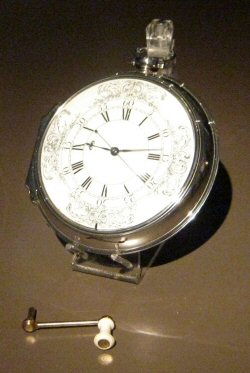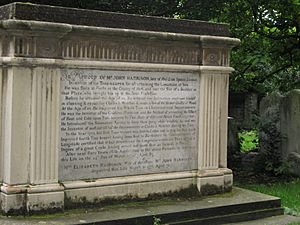William Harrison (instrument maker) facts for kids
William Harrison (born May 20, 1728, died April 24, 1815) was a skilled English instrument maker. He was the son of John Harrison, who invented the marine chronometer. This special clock helped sailors find their exact location at sea.
Contents
William's Early Life
William was born in a place called Barrow-upon-Humber. Later, he moved to London. He went there to help his father, John, create and improve the amazing sea clocks.
Developing Sea Clocks
William played a huge part in testing his father's inventions.
First Sea Voyage
In 1761, William sailed to Jamaica on a ship called HMS Deptford. He was in charge of his father's newest invention, the "sea watch." Today, we know this clock as the H4 marine watch. This trip was a very important test for the clock.
The Longitude Prize
The British Parliament had offered a huge prize of 20,000 pounds. This money would go to anyone who could find a way to accurately figure out a ship's longitude (its east-west position) at sea. The Board of Longitude was created to judge these inventions.
Testing the H4 Watch
The H4 watch worked very well during its first trip. It was super accurate and reliable. It helped sailors find their longitude correctly. However, the Board of Longitude wanted more proof. They asked for a second trip across the Atlantic Ocean.
Second Sea Voyage
So, in 1764, William took the H4 watch on another journey. He sailed to Barbados on HMS Tartar. Even after this second successful trip, the Board of Longitude was still not fully convinced. They didn't think the Harrisons had met all the rules for the prize.
King George III's Help
William then worked with his father, who was quite old by then. Together, they made a new clock called the H5 chronometer. In 1772, they showed it to King George III. The king was very impressed! He supported them in their fight to get the prize money from Parliament. In the end, they did receive some money, but not the full 20,000 pounds.
Other Important Roles
William Harrison was also involved in many other important activities.
Royal Society Member
In 1765, William was chosen to be a Fellow of the Royal Society. This is a very respected group for scientists. People recognized him as someone very skilled in mechanics and useful mechanical learning. He was known for his careful experiments to find longitude at sea.
Helping Children and Community
William was a leader at the Foundling Hospital. This hospital cared for and educated children who had been abandoned. He even helped teach music to the children there. He also held important roles in government. He was a deputy lieutenant in Monmouthshire and Middlesex. In 1791, he was chosen as the High Sheriff of Monmouthshire.
Death
William Harrison passed away in 1815. He was buried in his father's tomb at St John's churchyard in Hampstead. The tomb has an inscription that talks about his life and his important work helping his father with the sea watches and the prize. It also mentions his work at the Foundling Hospital.



